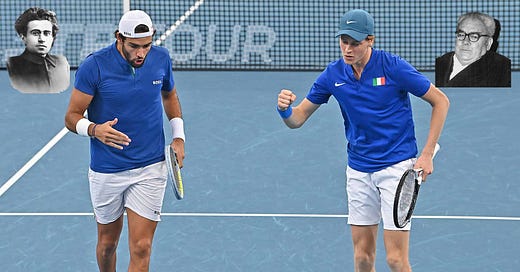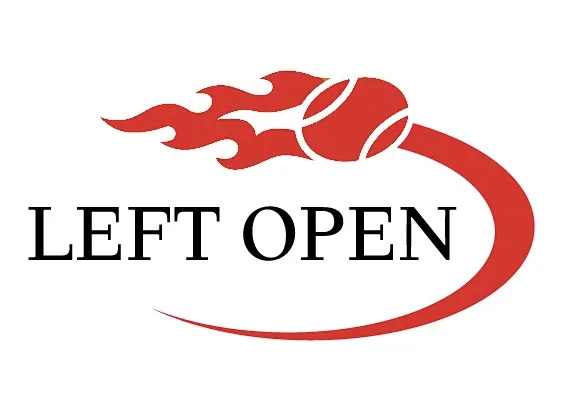Are We Approaching a Golden Age of Italian Tennis?
A spirited conversation between Italian American comrades
Day 4 of Left Open, Club Leftist Tennis’ daily leftist coverage of the 2022 US Open.
Italy is a land of contrasts: from the mountains of the Alps to the rocky shores of Sicily, from the vicious fascism of Benito Mussolini to the marxist humanism of Antonio Gramsci, from the powerful forehand of Matteo Berrettini to the artful one-handed backhand of Lorenzo Musetti. While 4 male Italian players remain in the US Open draw, their tendencies and prospects for revolutionary success couldn’t be more different. In order to conduct a rigorous materialist analysis of the current conditions that lead us here, we brought together two Italian American members of Club Leftist Tennis community, including our ATP insider Jackson Frons, in conversation.
CLT Paisan: Ciao amico. Grazie for joining me for this important conversation on the state of Italian tennis. To start off, I think we should talk about the material conditions of Italian tennis, namely, the court materials.
ATP Insider: Italy is, of course, a red clay nation, but the surface spiritually belongs more to France and Spain. The French of course have the only clay court slam and the Spaniards–from Guillermo Villas to Nadal–have cornered the market on kings of clay. While Italians certainly thrive on the surface, the red dirt doesn’t feel intrinsic to the identity of Italian tennis.
CLT Paisan: It also must be mentioned that the Next Gen ATP Finals has been located in Milan since its inception in 2017. Has that raised the profile of Italian tennis at all?
ATP Insider: And played indoors, not on clay, I must point out. I wouldn’t say the Next Gen Finals have raised the profile of tennis in Italy as much as the event embodies the newly bright outlook of Italian tennis. Let’s remember, an Italian man hasn’t won a slam since the 70s. The Italian wild-card at the inaugural Next-Gen event was Gianluigi Quinzi, who is of course notorious for training not in the motherland, but in Florida, under the tutelage of Italian-American paratrooper Nick Bolletieri. He was woefully over matched. Now, you look at the Race to Milan rankings on the ATP site and there are eight Italians in the top 25, two in the top eight, no wild card needed. I think we’re entering a golden future of Italian tennis.
CLT Paisan: Lets touch upon the two highest ranked players currently representing il Tricolore, Jannik Sinner and Matteo Berrettini. While they both play for Italy, their playing styles and the culture that their games developed in are completely different. While Berrettini was born in the Eternal City, Rome, Sinner hails from the largely German-speaking San Candido, and grew up in the ski resort town of Sesto where he began his athletic career on the slopes as one of Italy’s top junior skiers. How do you think this plays out on the court?
ATP Insider: Well firstly, I would like to call into question the idea that Sinner is Italian at all. As a Sicilian, I’m wary of the Germanic ways of the north. And he does possess a strain of factory precision to his game. He’s a learned talent, without the customary flair one finds further down the boot. However, his maximalist all-court game is certainly steeped in the theory of Italian marxist Amadeo Bordiga - his ultraleftism matches the ultra topspin he adds to his two handed backhand. In trying to cover the entire court with quick movements and powerful strokes, he seems to want revolution immediately, eschewing participation in bourgeois elections and often lacking a variety in tactics.
In his match against Eubanks today, look for him to dispatch the lanky, big serving American in 3 or 4 sets. Like many capitalists, Eubanks is unbalanced and weak on the backhand side. As the points get longer, expect Sinner to pounce.
CLT Paisan: What about Signore Berrettini?
ATP Insider: Berrettini is more of an organic intellectual in the Gramscian tradition. Born in Rome, this 6’ 5’’ Hugo Boss model is a total jock, but, in the Italian tradition, is not without emotion. While Sinner plays with a relentless cool, Berretttini roils with intensity of a Calabrian chili. Relying on his powerful serve and forehand, Berrettini’s brute strength is a force to be reckoned with on tour. Along with his Lazio origins and connection to the fashion world, his casual racism probably gives him the biggest claim to being the most authentically Italian man with a chance to win the tournament. Always a danger on fast surfaces, he’s also the only Italian in the men’s draw to make it to a Grand Slam Final (Wimbledon 2021) and is the only paisan to make it to the semifinals at the US Open (2019).
In his next match against Murray, watch for a tight first couple sets, but expect the Roman to overwhelm the Brit’s defenses and power (much like the Roman conquest of the British Isles under Emperor Claudius) through to the fourth round.
CLT Paisan: Moving on to the youngest of our fratelli, the 20 year old Lorenzo Musetti has been identified as a potential rising star, especially since winning the 2022 Hamberg European Open. Much like the spirited discussion around the “Alcaraz Question,” I think it’s important to ask: is his rise leftist in nature?
ATP Insider: I think Musetti’s (far more sputtering) rise is more leftist in nature than the Alcaraz Blitzkrieg. In Musetti’s game I think you see the beginnings of a truly Italian style of tennis–power, touch, elegance, an appreciation of bad night club music–without the more off-putting (or uninteresting) streaks you find in Berrettini or Fognini or Sinner. That isn’t to say Musetti’s game is without flaw–he struggles with consistency, particularly on serve, and is prone to lapses in form and focus. But his tennis, to me, feels propelled by a revolutionary zeal, a true joy, an operaismo that uplifts rather than degrades.
In his match against Brouwer today expect Musetti’s talent to shine through, but also expect him to bungle a lead of some kind and let things needlessly end up in the fifth set. I say he still gets the win.
CLT Paisan: Finally, we arrive at the elder statesman of Italian tennis, the 35 year old Fabio Fognini.
ATP Insider: Fognini is the Eurotrash populist icon of the bunch. If he was an ambassador for an equivalent tournament to Berrettini’s Boss Open, it would be an EDM festival/ATP 250 in Ibiza. He’s a clay courter, yet he relies on crisp, flat ball striking. He often has massive emotional meltdowns and tanks matches, yet also frequently comes back from two sets down. Fognini is a man of contrasts (that is, with the exception of his unilaterally terrible tattoos).
Fognini plays Nadal tonight on Arthur Ashe, and expect him to put on a show. Watch for operatic outbursts, stunning backhand winners, and a spirited four set defeat.
CLT Paisan: While I for one will be rooting for our Italian men, there is one glaring weakness that I don’t think can be overlooked. With full knowledge that politics has become totally intermeshed with aesthetics these days, I must ask: why do our Italian Men have such bad tattoos?
ATP Insider: Comrade, if only I knew.










In the spirit of revolutionary criticism, I take issue with some of your categorizations. Berrettini is not the embodiment of Gramscian marxism, either in terms of his playing style, which is utterly imbalanced between overpowering and one-dimensional serve/forehand and underdeveloped backhand, nor in terms of his choice of clothing sponsor, the one time designer of Waffen SS uniforms. I see him as an infiltrator, a tennis version of Disneyland, seemingly innocuous nice-guy with good popularity among the proletariat, but without self awareness of his fundamentally North American principles.
Musetti, on the other hand, is an Italian Jacques Verges. Not a theorist per se, but a dandy who potentially augments longer term causes of the Left, albeit by seemingly taking on issues precious to the Right.
I see Sinner as the closest to Gramsci. Sinner's game style is the long march through the institutions of baseline rallies, looking opportunistically for moments of weakness or contradiction which can be exploited to create more space for political winners. Without any capital-intensive devastating weapons, he has to rely on the weapons of the partisans - numbers, percentages, and tactical intelligence.
One final aside - I take issue with the characterization of clay as fundamentally non-italian. As a matter of fact, one of the two "Spanish" players you mentioned, Guillermo Vilas, is Argentinian, which, as everyone in Latin America knows, is far closer to Italy than Spain. Even their accent sounds Italian. Furthermore, the dethroned King of Clay was Bjorn Borg, a relentless germanic player in style, appearance, and in temperament if ever there was one. Clay is the multifaceted surface that builds a durable and deep understanding of tennis, accommodating to all nations and all personalities. It's the nascent fifth international, with revolutionary possibility embedded in every granule.